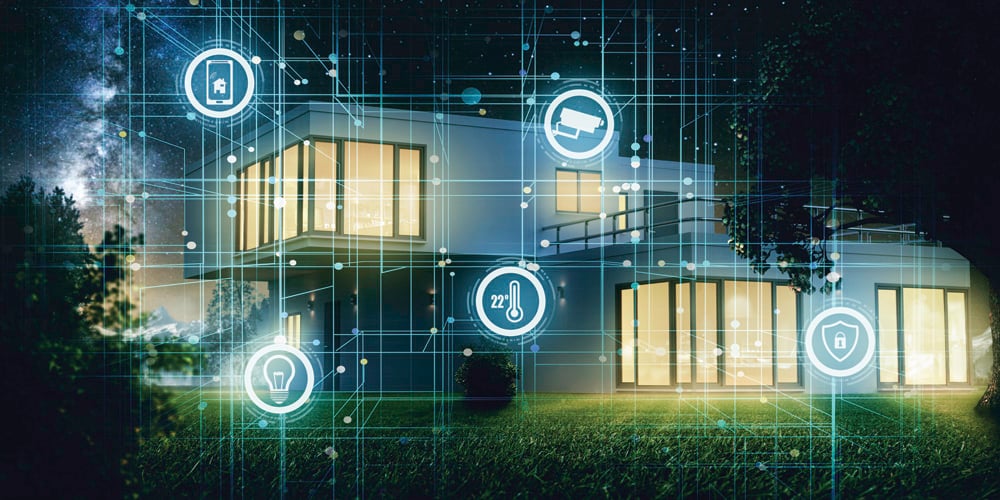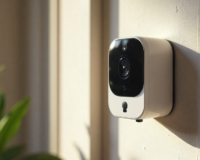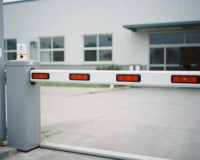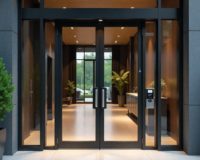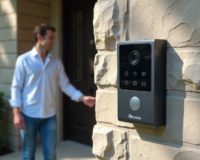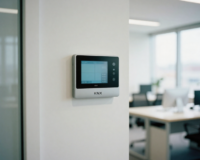In today’s rapidly evolving world, security has become a paramount concern for both residential and commercial buildings. Whether it’s protecting homes, office buildings, hotels, or public institutions, ensuring safety through robust access control and alarm systems is essential. KNX, a leading global standard for building automation, offers comprehensive solutions for managing access control and alarm systems. These solutions provide seamless integration, high scalability, and enhanced security, making them suitable for various applications.
This article delves into the KNX-based solutions for access control and alarm systems, exploring how they enhance security, provide flexibility, and improve the overall management of building environments.
Table of Contents
ToggleThe Role of KNX in Access Control Systems
1. Overview of Access Control
Access control is the selective restriction of access to a place or resource. In the context of buildings, it involves controlling who can enter certain areas, at what times, and under what conditions. Traditional access control systems relied heavily on mechanical locks and keys, but modern solutions have evolved to include electronic access control, offering greater flexibility, security, and convenience.
2. KNX-Based Access Control Systems
KNX offers a sophisticated platform for implementing access control systems that are integrated with other building automation functions. KNX-based access control systems can manage and monitor access points such as doors, gates, elevators, and parking lots. These systems utilize various authentication methods, including keycards, biometric readers, PIN codes, and mobile devices, to ensure that only authorized individuals can access restricted areas.
3. Key Features of KNX Access Control Solutions
- Integration with Building Management Systems (BMS): KNX access control systems can be seamlessly integrated into a building’s existing BMS, allowing for centralized control and monitoring. This integration ensures that access control is coordinated with other building functions, such as lighting, HVAC, and security systems, enhancing overall building management.
- Scalability: KNX systems are highly scalable, making them suitable for both small residential buildings and large commercial complexes. Whether you need to control access to a single door or manage thousands of access points across multiple locations, KNX can accommodate your needs.
- Customizable Access Permissions: KNX allows for the customization of access permissions based on various factors, such as time of day, user role, or specific events. For example, employees might have access to certain areas during working hours, while restricted areas remain accessible only to authorized personnel.
- Real-Time Monitoring and Reporting: KNX access control systems provide real-time monitoring of access points, allowing security personnel to track who enters and exits the building, and when. Detailed reports can be generated for audit purposes, helping organizations maintain a secure environment.
- Integration with Video Surveillance: KNX systems can be integrated with CCTV cameras to provide visual verification of individuals accessing restricted areas. This integration enhances security by allowing for real-time monitoring and recording of access events.
4. Applications of KNX Access Control Systems
- Residential Buildings: In residential settings, KNX access control systems can be used to manage entry to individual apartments, communal areas, and parking facilities. Residents can use keycards or mobile apps to access their homes, while visitors can be granted temporary access via PIN codes or intercom systems.
- Commercial Buildings: For office buildings, KNX access control systems can manage employee access to different floors, offices, and meeting rooms. The system can also control visitor access, ensuring that only authorized guests can enter specific areas.
- Hotels: In hotels, KNX access control systems can enhance the guest experience by providing seamless access to rooms, spas, gyms, and other amenities. Guests can use keycards or mobile apps to enter their rooms, and hotel staff can manage access to restricted areas, such as staff-only zones and storage rooms.
- Healthcare Facilities: In hospitals and clinics, KNX access control systems help secure sensitive areas, such as operating rooms, pharmacies, and patient wards. Access can be restricted to authorized medical staff, ensuring that patient privacy and safety are maintained.
The Role of KNX in Alarm Systems
1. Overview of Alarm Systems
Alarm systems are designed to detect and alert occupants of potential security threats, such as intrusions, fires, or environmental hazards. Traditional alarm systems were standalone solutions, but modern systems are increasingly integrated with other building automation functions, providing more comprehensive and coordinated responses to emergencies.
2. KNX-Based Alarm Systems
KNX offers advanced solutions for implementing alarm systems that are fully integrated with other building management functions. These systems can monitor a wide range of sensors, including motion detectors, smoke detectors, gas detectors, and glass break sensors, and trigger alarms in response to detected threats. KNX-based alarm systems can be customized to meet the specific needs of residential, commercial, and public buildings.
3. Key Features of KNX Alarm Systems
- Integration with Other Building Systems: KNX alarm systems can be integrated with lighting, HVAC, and access control systems to provide a coordinated response to emergencies. For example, in the event of a fire, the system can automatically unlock exit doors, turn on emergency lighting, and shut down HVAC systems to prevent the spread of smoke.
- Remote Monitoring and Control: KNX alarm systems can be monitored and controlled remotely via mobile apps or web interfaces. This allows building managers or security personnel to receive alerts, view live sensor data, and control the system from anywhere.
- Scalability and Flexibility: Like other KNX solutions, alarm systems are highly scalable and can be adapted to the specific needs of different building types. Whether it’s a small residential home or a large industrial complex, KNX alarm systems can be configured to provide the necessary level of protection.
- Customizable Alarm Responses: KNX allows for the customization of alarm responses based on the type of threat detected. For instance, a different sequence of actions might be triggered for an intrusion alarm compared to a fire alarm. This ensures that the response is appropriate for the situation, minimizing the risk to occupants and property.
- Event Logging and Reporting: KNX alarm systems provide detailed logs of all events, including sensor activations and alarm triggers. These logs can be used for post-incident analysis, helping to improve security protocols and response strategies.
4. Applications of KNX Alarm Systems
- Residential Buildings: In homes, KNX alarm systems can monitor for intrusions, fires, gas leaks, and flooding. The system can be integrated with smart home devices to provide automated responses, such as turning off the water supply in case of a leak or sending alerts to the homeowner’s smartphone in case of a security breach.
- Commercial Buildings: For office buildings and retail spaces, KNX alarm systems provide comprehensive security by monitoring entry points, sensitive areas, and environmental conditions. The system can trigger alarms, notify security personnel, and initiate automated responses, such as locking down the building or activating emergency lighting.
- Hotels: In hotels, KNX alarm systems ensure the safety of guests and staff by monitoring for potential threats, such as unauthorized access to restricted areas, fire hazards, and gas leaks. The system can be integrated with guest room management systems to provide personalized alerts and guidance during emergencies.
- Healthcare Facilities: Hospitals and clinics require stringent security and safety measures to protect patients, staff, and sensitive areas. KNX alarm systems provide continuous monitoring of critical areas, such as operating rooms, drug storage facilities, and patient wards, ensuring a rapid response to any potential threats.
Integration of Access Control and Alarm Systems with KNX
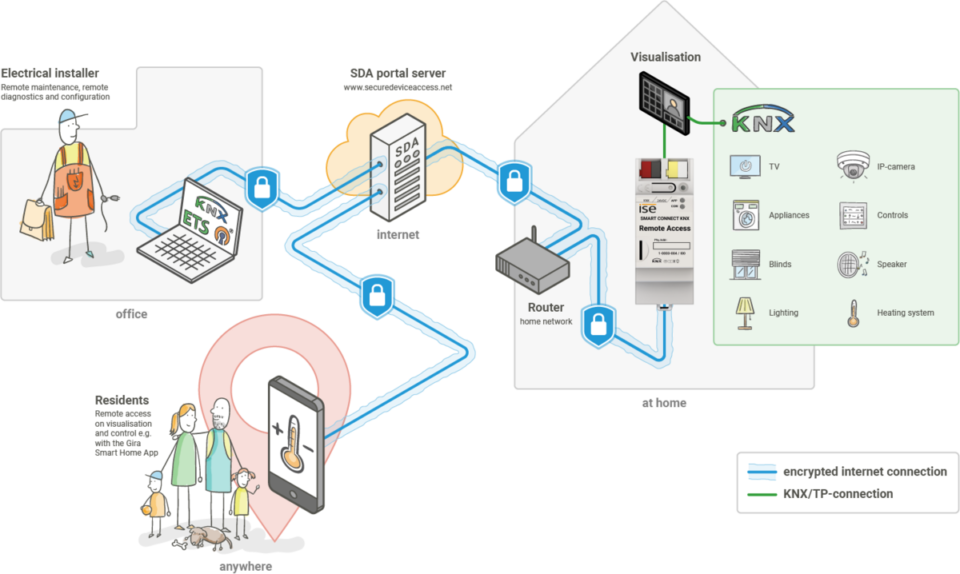
1. Seamless Integration
One of the most significant advantages of using KNX for access control and alarm systems is the ability to integrate these systems seamlessly. In a KNX-based building automation system, access control and alarm systems can communicate with each other and with other building functions, such as lighting, HVAC, and security cameras. This integration enables a more coordinated and efficient response to security threats.
2. Coordinated Responses
When access control and alarm systems are integrated via KNX, they can work together to enhance security. For example, if an unauthorized entry is detected by the access control system, the alarm system can be automatically triggered, and security cameras can be directed to focus on the area of interest. Additionally, emergency lighting can be activated, and doors can be locked or unlocked as needed to facilitate a safe response.
3. Centralized Management
KNX allows for centralized management of access control and alarm systems through a single interface. Building managers or security personnel can monitor and control all aspects of security from one location, reducing the complexity of managing multiple systems. This centralized approach also improves situational awareness, enabling quicker and more effective decision-making during emergencies.
4. Enhanced User Experience
For users, the integration of access control and alarm systems via KNX provides a more seamless and intuitive experience. For example, employees entering a building after hours can disarm the alarm system using their access credentials, avoiding the need for multiple steps. Similarly, hotel guests can feel more secure knowing that their room’s access control system is integrated with the hotel’s overall security and alarm infrastructure.
5. Scalability and Future-Proofing
As with other KNX-based systems, the integration of access control and alarm systems is highly scalable. Buildings can start with basic functionality and expand the system as needed, adding more access points, sensors, or alarm zones over time. KNX’s open standard also ensures that the system remains future-proof, capable of integrating with new technologies and devices as they become available.
Case Studies of KNX Access Control and Alarm Systems
1. High-Security Office Complex
A large corporate office complex implemented a KNX-based access control and alarm system to enhance security and streamline building management. The system controlled access to various floors, offices, and server rooms, with biometric readers used for high-security areas. The alarm system monitored for intrusions, fire hazards, and environmental conditions, providing real-time alerts and automated responses.
Results:
- Improved Security: The integration of access control and alarm systems provided a comprehensive security solution that significantly reduced unauthorized access and improved the response to potential threats.
- Operational Efficiency: The centralized management system allowed building staff to monitor and control security functions from a single interface, reducing the complexity of managing multiple systems and improving overall operational efficiency.
- Enhanced Incident Response: The real-time monitoring and coordinated response features enabled a faster and more effective reaction to security breaches and emergencies, minimizing potential damage and enhancing safety.
2. Luxury Hotel Chain
A luxury hotel chain utilized KNX technology to enhance both guest experience and security across its properties. The KNX-based system managed access to guest rooms, amenities, and staff-only areas, while also integrating with the hotel’s alarm system to provide comprehensive safety and security measures.
Results:
- Seamless Guest Experience: Guests enjoyed a seamless experience with keycard access to their rooms and personalized room settings. The integration with the alarm system ensured that guest safety was prioritized, with automated responses in case of emergencies.
- Operational Improvements: Hotel staff benefited from centralized control over access and alarm systems, allowing for more efficient management of security and emergency responses.
- Increased Guest Satisfaction: Enhanced security features and a smooth check-in/check-out process contributed to higher guest satisfaction scores and positive reviews.
3. Healthcare Facility
A large urban hospital integrated KNX-based access control and alarm systems to enhance security and safety within its complex. The system managed access to critical areas, such as operating rooms and pharmaceuticals, while also monitoring for environmental hazards and intrusions.
Results:
- Enhanced Security: The hospital successfully secured sensitive areas, preventing unauthorized access and ensuring that only authorized personnel could enter critical zones.
- Improved Patient Safety: The alarm system’s integration with environmental sensors allowed for early detection of potential hazards, such as smoke or gas leaks, improving overall patient safety.
- Efficient Emergency Response: Automated responses and real-time alerts enabled quick action during emergencies, contributing to a safer and more controlled hospital environment.
Read more: Applications of KNX in Office Buildings, Hotels, and Hospitals
Conclusion
KNX solutions for access control and alarm systems represent a powerful advancement in building security and management. By integrating these systems within a KNX-based building automation framework, users benefit from enhanced security, seamless coordination, and centralized control.
As the demand for advanced security solutions continues to grow, KNX will remain at the forefront of building automation technology, providing innovative and effective solutions for access control and alarm systems. By leveraging the power of KNX, building owners and managers can enhance security, improve operational efficiency, and ensure a safer and more secure environment for all occupants.
Read more: How to Become a Certified KNX Partner

